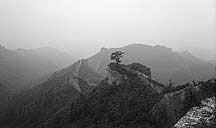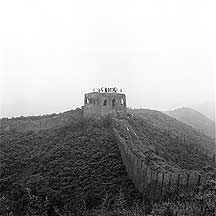 Continues from 古北口Gubeikou Town:
Continues from 古北口Gubeikou Town:
After spending much of yesterday looking for a path up the Wall, I gave up and decided to climb the nearby 卧虎山长城Wohu Shan Wall, which is the section of the Great Wall that winds through the western part of the 燕山Yanshan (Yan Mountains). The next morning, my guesthouse owner, Mr. Pang, showed me up the Panlongshan Wall, and there I set out toward east at 8:20 in the morning. I reached my first tower an hour later; then climbed the grand 将军楼General's Tower at 10:45.
By one in the afternoon, I had reached the twenty-fourth tower — the end of this Wall; ahead is the sealed section of the 五里陀长城Wulituo Great Wall use by the military.
From beginning to end, the Wall was either crumbled and bare or covered with vegetation; even trees were grown on it. Much of the top had been levelled, and in many areas had been filed to its base — by the powers of nature and gunpowder. Its protective parapets were all gone — like a dragon without its scales. And its brick skin had also fallen off, sometimes in a single large sheet; all that is remaining is the rammed earth core with the filled stones.
These embedded stones and rocks can be very sharp — so watch out. Parallel to the Wall, and along its base, is sometimes a narrow footpath; so, when the Wall is impossible to walk along on its top or when it is not safe to do so, the footpath should be used and vice-versa. To prevent further stress to the Wall, use the footpath whenever possible.
I passed much of the Wall quickly, mainly because it started drizzling, but also because I did not bring enough food and water for a night here. My bag was already a quarter of my weight and my tripod was an extra burden. Fortunately, this part of the Wall was not difficult to walk because the hills in this area have mostly low curves and shallow valleys. But at some sections I had to climb on all fours, which was clumsy as I had only one free hand. Meanwhile the rain came on and off, so I was a little wet.
At times I wish I can hide, but the towers were all roofless and crumbled.
One of the unforgetable experiences on the Wall is the enhance awareness of the surrounding. There is a distinct advantage being on a higher plane — anything below, even several mountains away, can be easily spotted. So too are the sounds, which I can hear long before I can see the object producing it. At he height of its glory, the Wall was certainly a speedway that moved traffic swiftly and efficiently through the mountains. Today it lay in ruins and with no traffic. For hours I only hear the chronic echoing shrills of wild birds. But none appeared in the wide green rolling hills. Nor was there houses or smoke in the distance. Then a fog hovered in the distance, and it was building up rapidly.
As I was near the General's Tower I heard sounds of people. I was about two hills away when tiny dots appeared moving up the tower. These turned out to be young Beijing natives who had just hiked here from the nearby ticket entrance. Following them were two Great Wall staffs, and of course I had to buy the ticket from them. They can be identified by the gray pin on their shirts with a number.
The staffs were surprised I was travelling alone, as they are accustomed to seeing groups. They wanted to know where I was heading, so I said 司马台Simatai. The two women nodded, so I asked if it is possible to reach there today. Maybe, if I walk very fast. Next I asked for directions to get to the next section, which is 金山岭Jinshanling. "Once you reach the 24th tower, there will be a dead end. So you must get off the wall on the 23rd tower and follow a small path down and around the restricted section." After a few more questions I thanked them and went my way.
In about 2 hours I hit the dead end. I went back a tower and sure enough there was a narrow path - two paths to be precise, one closer to the wall and the other down. I first tried the path closest to the wall but found it slightly dangerous, so I opted for the other. And so began my journey down the rabbit hole. It was a jungle. Down on the valley I was lost for the next 4 hours. In the end, I was able to get up Jinshanling Great Wall — but at 5 in the afternoon.
Continue reading 






















